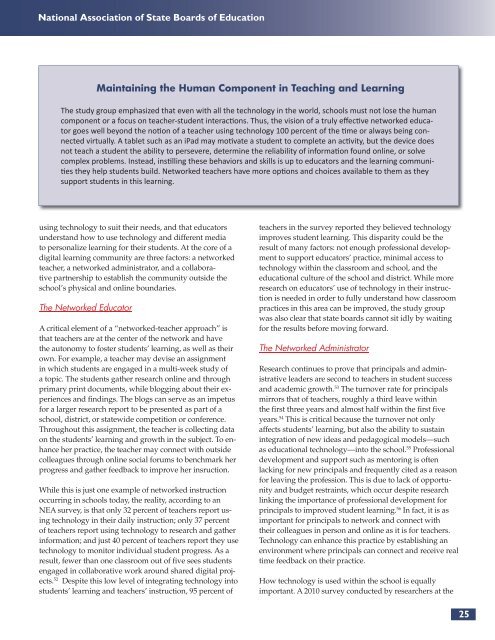You also want an ePaper? Increase the reach of your titles
YUMPU automatically turns print PDFs into web optimized ePapers that Google loves.
National Association of State Boards of Education<br />
using technology to suit their needs, and that educators<br />
understand how to use technology and different media<br />
to personalize learning for their students. At the core of a<br />
digital learning community are three factors: a networked<br />
teacher, a networked administrator, and a collaborative<br />
partnership to establish the community outside the<br />
school’s physical and online boundaries.<br />
The Networked Educator<br />
Maintaining the Human Component in Teaching and Learning<br />
The study group emphasized that even with all the technology in the world, schools must not lose the human<br />
component or a focus on teacher-student interac� ons. Thus, the vision of a truly eff ec� ve networked educator<br />
goes well beyond the no� on of a teacher using technology 100 percent of the � me or always being connected<br />
virtually. A tablet such as an iPad may mo� vate a student to complete an ac� vity, but the device does<br />
not teach a student the ability to persevere, determine the reliability of informa� on found online, or solve<br />
complex problems. Instead, ins� lling these behaviors and skills is up to educators and the learning communi-<br />
� es they help students build. Networked teachers have more op� ons and choices available to them as they<br />
support students in this learning.<br />
A critical element of a “networked-teacher approach” is<br />
that teachers are at the center of the network and have<br />
the autonomy to foster students’ learning, as well as their<br />
own. For example, a teacher may devise an assignment<br />
in which students are engaged in a multi-week study of<br />
a topic. The students gather research online and through<br />
primary print documents, while blogging about their experiences<br />
and fi ndings. The blogs can serve as an impetus<br />
for a larger research report to be presented as part of a<br />
school, district, or statewide competition or conference.<br />
Throughout this assignment, the teacher is collecting data<br />
on the students’ learning and growth in the subject. To enhance<br />
her practice, the teacher may connect with outside<br />
colleagues through online social forums to benchmark her<br />
progress and gather feedback to improve her insruction.<br />
While this is just one example of networked instruction<br />
occurring in schools today, the reality, according to an<br />
NEA survey, is that only 32 percent of teachers report using<br />
technology in their daily instruction; only 37 percent<br />
of teachers report using technology to research and gather<br />
information; and just 40 percent of teachers report they use<br />
technology to monitor individual student progress. As a<br />
result, fewer than one classroom out of fi ve sees students<br />
engaged in collaborative work around shared digital projects.<br />
52 Despite this low level of integrating technology into<br />
students’ learning and teachers’ instruction, 95 percent of<br />
teachers in the survey reported they believed technology<br />
improves student learning. This disparity could be the<br />
result of many factors: not enough professional development<br />
to support educators’ practice, minimal access to<br />
technology within the classroom and school, and the<br />
educational culture of the school and district. While more<br />
research on educators’ use of technology in their instruction<br />
is needed in order to fully understand how classroom<br />
practices in this area can be improved, the study group<br />
was also clear that state boards cannot sit idly by waiting<br />
for the results before moving forward.<br />
The Networked Administrator<br />
Research continues to prove that principals and administrative<br />
leaders are second to teachers in student success<br />
and academic growth. 53 The turnover rate for principals<br />
mirrors that of teachers, roughly a third leave within<br />
the fi rst three years and almost half within the fi rst fi ve<br />
years. 54 This is critical because the turnover not only<br />
affects students’ learning, but also the ability to sustain<br />
integration of new ideas and pedagogical models—such<br />
as educational technology—into the school. 55 Professional<br />
development and support such as mentoring is often<br />
lacking for new principals and frequently cited as a reason<br />
for leaving the profession. This is due to lack of opportunity<br />
and budget restraints, which occur despite research<br />
linking the importance of professional development for<br />
principals to improved student learning. 56 In fact, it is as<br />
important for principals to network and connect with<br />
their colleagues in person and online as it is for teachers.<br />
Technology can enhance this practice by establishing an<br />
environment where principals can connect and receive real<br />
time feedback on their practice.<br />
How technology is used within the school is equally<br />
important. A 2010 survey conducted by researchers at the<br />
25


